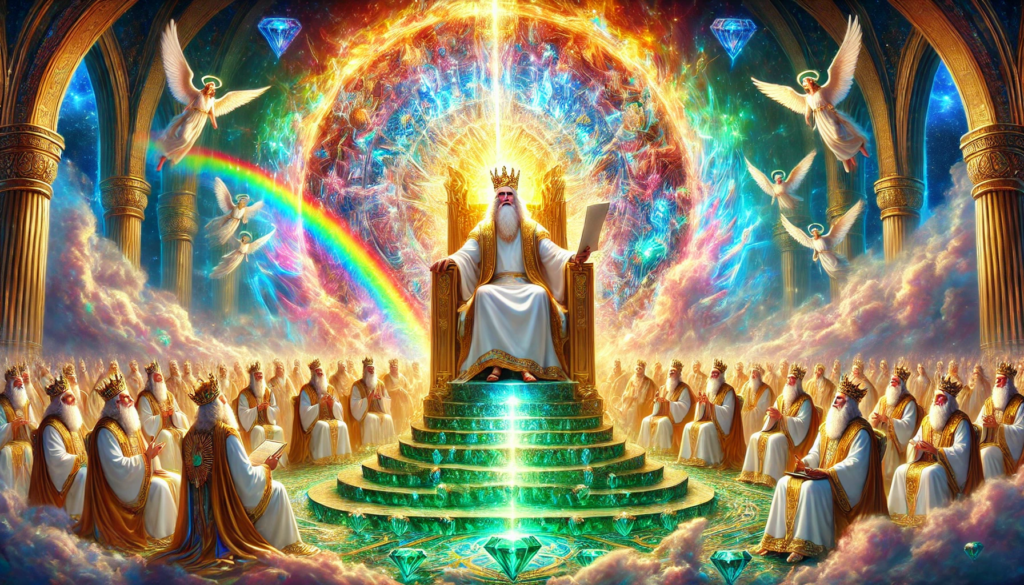Revelation #10: Revelation Chapter 5 – Glory to the Lamb
Revelation #10: Revelation Chapter 5 – Glory to the Lamb
The Unopened Scroll: Revelation 5:1-4
The Apostle John writes, “Then I saw in the right hand of him who sat on the throne a scroll with writing on both sides and sealed with seven seals” (Revelation 5:1). Here, we find a scroll tightly sealed, representing God’s ultimate plan for the future. However, this scroll cannot be opened by just anyone. A mighty angel proclaims, “Who is worthy to break the seals and open the scroll?” (Revelation 5:2).
Background: Understanding the Book of Revelation
Revelation, or Apocalypse in Greek, translates as “unveiling” or “revealing.” It opens with the phrase, “The revelation from Jesus Christ” (Revelation 1:1), signifying an unveiling of profound truths concerning Christ’s return and the ultimate judgment. This vision emphasizes God’s sovereignty and eternal nature, proclaiming Him as the Alpha and Omega (Revelation 1:8).
In the opening chapters, Christ appears to John, exiled on Patmos, and commands him to write what he sees. John witnesses Jesus in glorified form, describing Him as “His face was like the sun shining in all its brilliance” (Revelation 1:16). John’s immediate reaction is one of awe and fear, but Jesus reassures him, saying, “Do not be afraid. I am the First and the Last. I am the Living One; I was dead, and now look, I am alive for ever and ever!” (Revelation 1:17-18).
The Heavenly Throne: Revelation 4
Before addressing chapter 5, John paints a vivid image of God’s throne in heaven. This heavenly scene emphasizes God’s absolute authority over all creation. Around the throne, John describes an awe-inspiring scene: “A rainbow that shone like an emerald encircled the throne” (Revelation 4:3). God’s throne is resplendent, surrounded by 24 elders representing the redeemed, dressed in white and crowned with gold (Revelation 4:4), and four living creatures who constantly proclaim God’s holiness, crying, “Holy, holy, holy is the Lord God Almighty” (Revelation 4:8).
The Scroll and the Worthy One: Revelation 5
As the scene shifts, we observe a significant dilemma surrounding the scroll sealed with seven seals. The seals represent the judgments that will soon be poured out on the earth as part of God’s redemptive plan. The question asked is profound: Who is worthy to open the scroll? As the search reveals, no one in heaven or on earth or under the earth could open the scroll or even look inside it (Revelation 5:3). John weeps at the thought of a world continuing in its brokenness, without redemption.
But one of the elders consoles him, saying, “Do not weep! See, the Lion of the tribe of Judah, the Root of David, has triumphed. He is able to open the scroll and its seven seals” (Revelation 5:5). Here, we see a blend of two images – the Lion, symbolizing Christ’s kingly power, and the Lamb, representing His sacrificial nature. John sees the Lamb standing “as if it had been slain” with seven horns and seven eyes, signifying Christ’s perfect power and knowledge (Revelation 5:6).
The Lamb Takes the Scroll: Revelation 5:7-8
When the Lamb takes the scroll, heaven bursts into worship. The 24 elders and the four living creatures fall before Him, holding “harps and golden bowls full of incense, which are the prayers of God’s people” (Revelation 5:8). This portrays the powerful image that believers’ prayers are heard and cherished in the very throne room of God.
A New Song of Redemption: Revelation 5:9-10
The heavenly beings sing a new song, “You are worthy to take the scroll and to open its seals, because you were slain, and with your blood you purchased for God persons from every tribe and language and people and nation” (Revelation 5:9). This affirms Christ’s redeeming sacrifice, which extends beyond geographical, cultural, or racial boundaries. In Jesus, God has reconciled the world to Himself.
This act also restores humanity’s original purpose in creation. By His death and resurrection, Christ has made believers to be “a kingdom and priests to serve our God, and they will reign on the earth” (Revelation 5:10). This verse highlights our future role in God’s eternal kingdom, where believers will share in Christ’s reign.
Worship in Heaven: Revelation 5:11-14
John then sees “myriads upon myriads” of angels surrounding the throne, singing, “Worthy is the Lamb, who was slain, to receive power and wealth and wisdom and strength and honor and glory and praise!” (Revelation 5:12). The worship extends to every creature, proclaiming, “To him who sits on the throne and to the Lamb be praise and honor and glory and power, for ever and ever!” (Revelation 5:13). This worship scene shows that Christ’s redemption is cosmic in scope, encompassing all creation.

Reflection and Conclusion
Revelation 5 is a powerful reminder of the glory due to Jesus Christ. Though humanity fell into sin, Christ took on the role of Redeemer, restoring what was lost and initiating the ultimate fulfillment of God’s plan for creation. The Lamb who was slain stands victorious, ready to open the scroll, representing God’s final plan for the world.
In contemplating this vision, believers can find peace, knowing that Christ alone is worthy and has redeemed humanity through His sacrifice. The scene emphasizes that our prayers are valued, and one day, we will join the celestial chorus that praises the Lamb. Today, we have the opportunity to respond to this grace, acknowledging that Jesus Christ alone is worthy of our adoration and devotion.
-sermon series by Pastor Michel Bohrer
Listen to the KJV New Testament from Matthew to Revelation as a Podcast!
See Related Pages:
Sermons: key points from the series Revelation ; 50 facts/speculations on 666 in the Bible ;30 failed doomsday prophecies; Prophecies of Israel in the Bible: Fulfilled, Unfulfilled ; Bible Study on Revelation ; 5 Ways the Book of Revelation Has Influenced Modern Culture ; Art and Symbolism of Revelation ;Sermon Series Revelation ; Questions and Answers on Revelation
